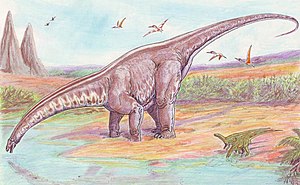Apatosaurus
| Apatosaurus | ||||||||||||
|---|---|---|---|---|---|---|---|---|---|---|---|---|

Apatosaurus , live reconstruction |
||||||||||||
| Temporal occurrence | ||||||||||||
| Upper Jurassic ( Kimmeridgian to Tithonian ) | ||||||||||||
| 157.3 to 145 million years | ||||||||||||
| Locations | ||||||||||||
| Systematics | ||||||||||||
|
||||||||||||
| Scientific name | ||||||||||||
| Apatosaurus | ||||||||||||
| Marsh , 1877 | ||||||||||||
| species | ||||||||||||
|
Apatosaurus ("deceptive lizard"; younger synonym [possibly related independent genus]: Brontosaurus ["thunderlizard"]) is a genus of sauropod dinosaurs from the family Diplodocidae . It is one of the most famous dinosaurs . Apatosaurus lived in the Upper Jurassic ( Kimmeridgian to Tithonian ), its fossils were found in the western United States ( Colorado , Oklahoma , Wyoming and Utah ).
Apatosaurus reached a length of 21 to 26 meters, its weight is estimated at 30 to 35 tons. He was strongly built, but not as long as the closely related, similarly built Diplodocus . However, its tail was longer and consisted of 82 vertebrae . It used to be discussed whether he used it to ward off enemies, but this seems unlikely because the tail was not built stably in the end, had no injuries and the tail's lateral mobility was limited. Perhaps, however, he could generate a sonic boom, this could have been used for intra-species communication. The skull, like that of all diplodocids, was long and low.
Like all sauropods, it was herbivorous. Petrified footprints running in parallel show that he lived in herds at least at times .
The American paleontologist Othniel Charles Marsh discovered the first fossils and named the animal Apatosaurus ajax in 1877 . Two years later he found other remains and described them as Brontosaurus excelsus . Since 1903 it has been assumed that the two genera are identical, and according to the rules of the International Code of Zoological Nomenclature (ICZN), the older name, in this case Apatosaurus , would have validity ( priority rule ). No skull of his was known until 1975, so until then it was mostly reconstructed with the skull of Camarasaurus . This is more compact and taller than the skull of Apatosaurus .
However, a study published in April 2015 comes to the conclusion that Brontosaurus is significantly different from Apatosaurus and is therefore valid as a separate taxon with the species Brontosaurus excelsus and Brontosaurus parvus . This found a wide echo in the popular scientific press and the daily press as the "resurrection of the Brontosaurus". However, it remains to be seen whether this revision will remain valid in the long term.
literature
- Paul Upchurch , Paul M. Barrett , Peter Dodson : Sauropoda. Paleobiology, Taphonomy, and Paleoecology. In: David B. Weishampel , Peter Dodson, Halszka Osmólska (eds.): The Dinosauria . 2nd edition. University of California Press, Berkeley CA et al. 2004, ISBN 0-520-24209-2 , pp. 273-295.
Web links
Individual evidence
- ^ Gregory S. Paul : The Princeton Field Guide To Dinosaurs. Princeton University Press, Princeton NJ et al. 2010, ISBN 978-0-691-13720-9 , pp. 192-194, online .
- ↑ a b E. Tschopp, O. Mateus, RBJ Benson: A specimen-level phylogenetic analysis and taxonomic revision of Diplodocidae (Dinosauria, Sauropoda) , 2015, doi : 10.7717 / peerj.857 .
- ↑ z. B .: Nadja Podbregar: The Brontosaurus is back. Image of Science, April 7, 2015, accessed April 8, 2015 .